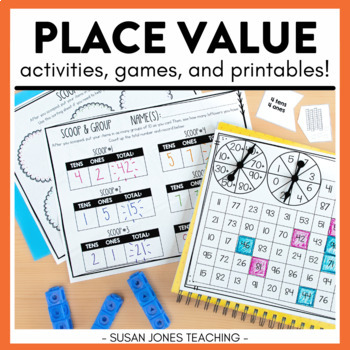Place Value Activities for First Grade!
Susan Jones
42k Followers
Grade Levels
K - 2nd
Subjects
Resource Type
Standards
CCSS1.NBT.B.2
CCSS1.NBT.B.2a
CCSS1.NBT.B.2b
CCSS1.NBT.B.2c
CCSS1.NBT.B.3
Formats Included
- PDF
Pages
55 pages
Susan Jones
42k Followers
What educators are saying
Great set of resource that helps with practice and review. Susan Jones always makes the most practical things!
I haven't used this yet this year, but I'm preparing to break it out to review concepts with students. I've used it in previous years, and it's a great resource.
Description
These place value activities and worksheets are the perfect hands on, interactive games for first grade!
GET THESE ACTIVITIES AND MORE BY PURCHASING MY MATH WORKSHOP BUNDLE FOR THE WHOLE YEAR! SEE MORE HERE!
The objectives of these lessons, activities, and printables are:
Students will be able to:
- Identify the 10s and 1s place
- Group items by 10s and leftovers
- Determine the value of each number
- Compare and Order Numbers up to 120
- Add and Subtract using place value
In this unit:
- Scoop & Group - Hands on place value activity
- Race to 50/100 - Hands on place value activity
- What’s My Value? - Hands on place value activity
- Spin & Find (Expanded Form) - Partner Printable Game
- Solve the Room - Individual practice with ordering & comparing #s
- Place Value Puzzles - Hands on place value activity
- Plus 10, Minus 10 - adding and subtracting 10s
- Addition & Subtraction Task Cards -- Hands on place value activity
- 8 Different Practice Pages
Download the preview to get a closer look at what's included!
Enjoy,
Susan Jones
Total Pages
55 pages
Answer Key
N/A
Teaching Duration
N/A
Report this resource to TPT
Reported resources will be reviewed by our team. Report this resource to let us know if this resource violates TPT’s content guidelines.
Standards
to see state-specific standards (only available in the US).
CCSS1.NBT.B.2
Understand that the two digits of a two-digit number represent amounts of tens and ones. Understand the following as special cases:
CCSS1.NBT.B.2a
10 can be thought of as a bundle of ten ones - called a “ten.”
CCSS1.NBT.B.2b
The numbers from 11 to 19 are composed of a ten and one, two, three, four, five, six, seven, eight, or nine ones.
CCSS1.NBT.B.2c
The numbers 10, 20, 30, 40, 50, 60, 70, 80, 90 refer to one, two, three, four, five, six, seven, eight, or nine tens (and 0 ones).
CCSS1.NBT.B.3
Compare two two-digit numbers based on meanings of the tens and ones digits, recording the results of comparisons with the symbols >, =, and <.





